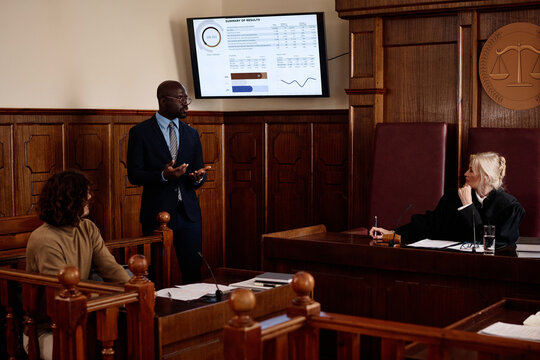Browsing the Complexities of Test Presentations: Tips for Seamless Shipment and Engaging Debates
In the world of lawful proceedings, the art of trial discussion stands as a critical factor of success. The complexities intrinsic in test presentations need a delicate balance of finesse, strategy, and skill.

Comprehending Test Objectives
To efficiently navigate a test, it is essential to have a clear understanding of the purposes that require to be achieved. Before tipping right into the court, lawful teams must specify their objectives and preferred end results. These goals act as directing principles throughout the test, shaping techniques and affecting decision-making processes.
Recognizing trial objectives includes a detailed evaluation of the instance, lawful precedents, and the client's ideal passions. Trial Presentations. It needs a careful evaluation of the truths, determining essential issues, and expecting prospective difficulties. By establishing specific and measurable goals, attorneys can tailor their presentations and disagreements to align with the preferred outcomes
Moreover, a clear grip of test objectives allows legal groups to focus on evidence, witnesses, and lawful arguments properly. It permits for the development of a systematic narrative that reverberates with the court and court, strengthening the overall instance discussion.

Organizing Evidence Successfully
Having a clear understanding of test goals lays the foundation for arranging evidence effectively in lawful proceedings - Trial Presentations. By straightening the discussion of proof with the preferred results of the trial, lawful groups can reinforce their arguments and enhance their persuasiveness. One critical facet of organizing evidence is classification. Grouping proof based on themes or relevance to specific lawful elements can help enhance the presentation and make intricate information extra absorbable for the court or jury.
An additional crucial element in arranging proof properly is establishing a rational circulation. Presenting proof in a sequential and meaningful manner can help construct a compelling narrative that supports the lawful arguments being made. In addition, utilizing aesthetic help such as timelines, charts, or graphes can better improve the company of proof and help in making clear complex connections or sequences of occasions.
In addition, ensuring that all evidence provided is admissible and relevant to the case is vital. Pointless or inadmissible evidence can interfere with the toughness of the disagreement and possibly damage the reliability of today event. A precise review and option procedure must be carried out to include just the most lawfully sound and impactful evidence in the test discussion.
Crafting Convincing Narratives
Crafting compelling narratives plays an essential role in offering influential arguments throughout lawful process. When creating a narrative for a trial discussion, it this page is vital to establish a clear story that highlights key factors and connects them in a coherent fashion. By weaving with each other proof, testimony, and legal arguments into a natural and convincing narrative, lawful experts can successfully advocate for their customers and raise the probability of a positive end result in the court room.
Understanding Visual Help
Reliable use visual aids is crucial to boosting the impact and quality of trial presentations. Visual aids, when used purposefully, have the power to streamline complicated details, enhance bottom lines, and leave a lasting impact on the judge and jury. To master visual help in test discussions, it is crucial to make sure that they are clear, succinct, and pertinent to the arguments being made.
When including aesthetic aids, visit our website such as charts, useful source photographs, charts, or timelines, right into a test presentation, it is important to keep them visually appealing yet expert. The visuals ought to enhance the spoken debates, providing an aesthetic representation of the information being discussed without frustrating the audience with unnecessary details.
Additionally, exercising with the visual help beforehand is imperative to make sure a seamless shipment during the trial. Familiarizing oneself with the material, changes, and timings of each aesthetic help can assist preserve the flow of the discussion and prevent technological problems that may develop.
Providing Impactful Closing Debates
A compelling closing argument offers as the conclusion of a trial presentation, enveloping the core narrative and convincing the judge and court in the direction of a favorable decision. Begin by detailing the major debates that sustain your customer's position, highlighting why the proof provided throughout the test supports your story.
Additionally, incorporating psychological appeal can additionally strengthen your closing argument. By connecting and humanizing the instance on a personal degree with the decision-makers, you can stimulate empathy and understanding, influencing their perception of the truths offered. Additionally, reiterating the legal standards that need to be met for a positive ruling can enhance the validity of your setting. Inevitably, a well-crafted closing disagreement should leave a long-term impact, engaging the judge and court to regulation in your customer's favor.
Final Thought
Finally, mastering trial presentations includes recognizing purposes, arranging evidence, crafting narratives, utilizing aesthetic help, and delivering impactful closing disagreements. By carrying out these methods efficiently, legal representatives can provide their situation effortlessly and make engaging debates in the courtroom. It is critical to browse the complexities of test discussions with precision and skill to attain success in lawful proceedings.
By straightening the presentation of proof with the desired end results of the trial, legal groups can strengthen their disagreements and improve their persuasiveness (Trial Presentations). To master aesthetic aids in trial discussions, it is crucial to ensure that they are clear, succinct, and appropriate to the arguments being made
An engaging closing debate offers as the conclusion of a trial discussion, encapsulating the core narrative and encouraging the court and jury in the direction of a positive decision. Begin by outlining the major disagreements that support your customer's position, stressing why the evidence provided throughout the trial supports your narrative.In verdict, grasping trial discussions involves understanding goals, organizing proof, crafting narratives, making use of visual help, and providing impactful closing disagreements.